创建和自定义需求可追溯性报告
为模型创建需求可追溯性报告
要为 Simulink® 模型创建默认需求报告:
打开示例模型:
openExample("slvnvdemo_fuelsys_officereq.slx")确保您当前的工作文件夹是可写的。
在 App 选项卡中,点击需求管理器。在需求选项卡中,选择 共享 > 生成模型可追溯性报告。
如果您的模型很大并且有许多需求链接,则需要几分钟才能创建报告。
报告在 HTML 查看器中打开。
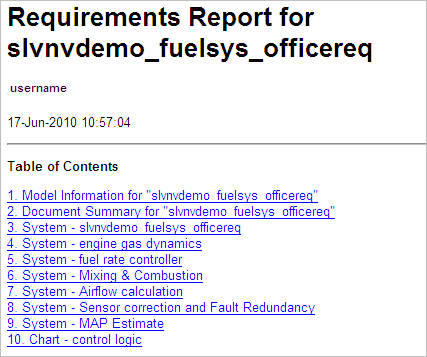
典型的需求报告包括:
目录
表列表
每个子系统的部分包括:
列出具有需求的对象并包含相关需求文档链接的表格
具有需求的对象的图形图像
无需求的对象列表
MATLAB® 代码行符合 MATLAB Function 模块中的需求
有关需求报告的详细信息,请参阅 自定义模型需求可追溯性报告。
如果您的模型有库引用模块
要包含与库引用模块相关的需求链接,您必须选择需求设置的报告选项卡下的包含在引用的库和数据字典中的链接,如 自定义需求报告 中所述。
如果您的模型有模型引用模块
默认情况下,模型中模型引用模块内的需求链接不包含在需求可追溯性报告中。要生成包含引用模型需求信息的报告,请按照Model 模块中的需求报告中的步骤操作。
自定义模型需求可追溯性报告
创建默认需求报告
如果您的模型包含指向外部需求文档的链接,则可以创建一个 HTML 报告,其中包含有关这些链接的摘要和详细信息。此外,报告还包含允许您导航至模型和需求文档的链接。
您可以生成一份默认报告,其中包含与模型及其对象相关的所有需求的信息。
注意
如果您要创建报告的模型包含 Model 模块,请参阅 Model 模块中的需求报告。
在生成报告之前,向 Stateflow® 图添加需求以查看需求报告包含的有关 Stateflow 图的信息:
打开示例模型:
openExample("slvnvdemo_fuelsys_officereq.slx")打开燃料速率控制器子系统。
打开 Microsoft® Word 需求文档:
openExample("slrequirements/" + ... "ManageReqsForFaultTolerantFuelCtrl" + ... "SysMicrosoftOffice07Example", ... supportingFile= ... "slvnvdemo_FuelSys_RequirementsSpecification.docx")
创建从控制逻辑 Stateflow 图到此文档中某个位置的链接。
保持示例模型打开,但关闭需求文档。
要为 slvnvdemo_fuelsys_officereq 模型生成默认需求报告,请在需求选项卡中选择 共享 > 生成模型可追溯性报告。
需求管理接口 (RMI) 在模型中的所有模块和子系统中搜索相关需求。Requirements Toolbox™ 生成并以 HTML 格式显示完整的报告。
报告以默认名称 model_name_requirements.html
报告主要内容如下:
目录. 目录列出了报告的主要部分。顶层模型有一个系统部分,每个子系统、Model 模块或 Stateflow 图有一个系统部分。
点击链接可以查看有关模型特定部分的信息。

表列表. 表列表包含报告中每个表格的链接。
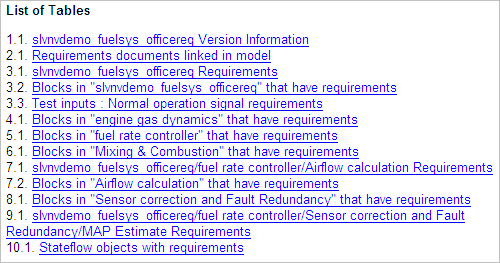
模型信息. 模型信息包含有关模型的一般信息,例如模型的创建时间以及模型的最后修改时间。
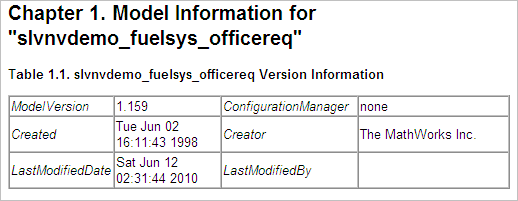
文件摘要. 文档摘要部分列出了 slvnvdemo_fuelsys_officereq 模型中的对象链接到的所有需求文档,以及有关每个文档的一些附加信息。
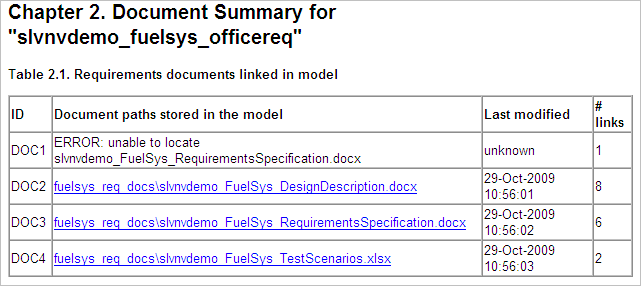
ID - ID。在此示例中,DOC1、DOC2、DOC3 和 DOC4 是从此模型链接的需求文档的简称。
在生成报告之前,在“设置”对话框的报告选项卡上,如果选择在需求表中使用文档 ID,则在引用需求文档时,带有这些简称的链接将包含在整个报告中。当您点击报告中的简称链接时,与该文档 ID 关联的需求文档将会打开。
当您的需求文档具有较长的路径名而可能使报告混乱时,请选择在需求表中使用文档 ID 选项。此选项默认是禁用的,正如您在本节的示例中所看到的。
模型中存储的文档路径 - 点击此链接可在本机应用程序中打开需求文档。
最后修改时间 -需求文档最后修改的日期。
# 个链接 -需求文档的总链接数。
系统. 每个系统部分包括:
模型或模型对象的图像。具有需求的对象会突出显示。
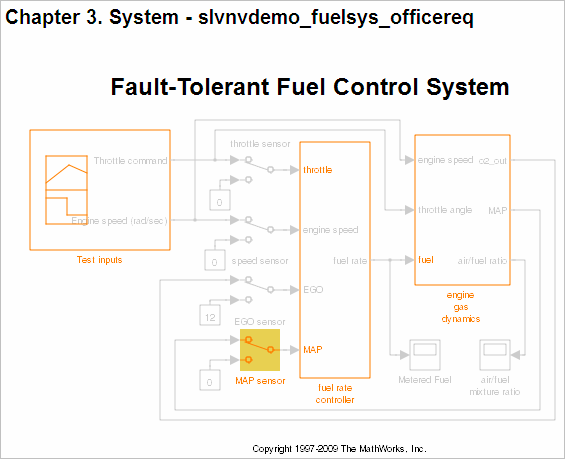
与模型或模型对象相关的需求列表。在此示例中,点击目标文档名称即可打开与
slvnvdemo_fuelsys_officereq模型相关联的需求文档。
顶层模型中具有需求的模块的列表。在此示例中,只有 MAP 传感器模块在顶层有需求。点击目标旁边的链接以打开与 MAP 传感器模块相关的需求文档。
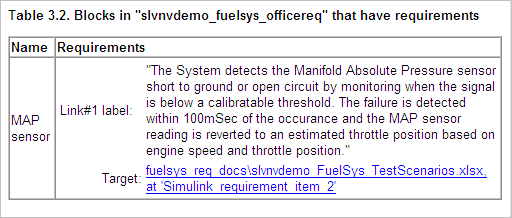
上表未在顶层模型中包含这些模块,因为:
燃料速率控制器和发动机气体动力学子系统位于报告的专门章节中。
报告单独列出了 Signal Builder 模块,在此示例中,在表 3.3 中。
与任何 Signal Builder 模块中每个信号组相关的需求列表,以及该信号组的图形。在此示例中,顶层模型中的测试输入 Signal Builder 模块有一个包含需求链接的信号组。点击模板(文档名称和位置 ID) 下的链接即可在测试输入模块中打开与该信号组相关的需求文档。
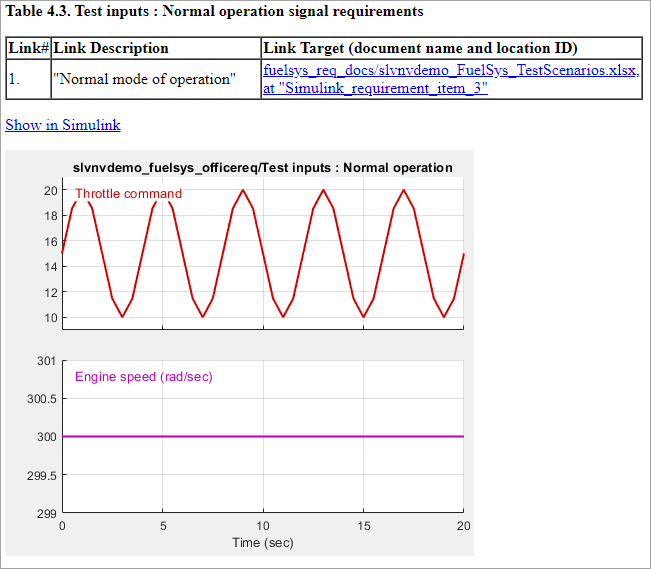
图. 每个图部分报告 Stateflow 图中的需求,并包括:
Stateflow 图的图形可标识每个状态。
具有需求的元素列表。
要导航到与图元素相关的需求文档,点击目标旁边的链接。
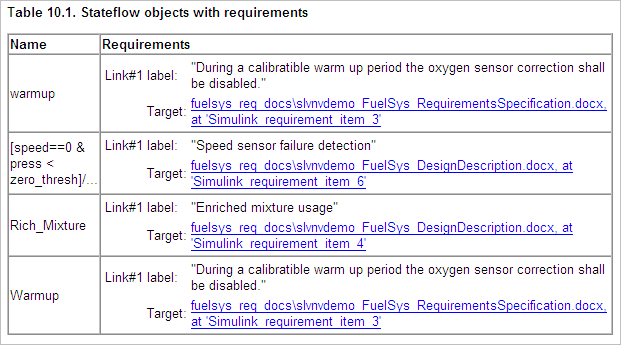
Model 模块中的需求报告
如果您的模型包含引用外部模型的 Model 模块,则默认报告不包含有关引用模型中需求的信息。要生成包含引用模型需求信息的报告,您必须拥有 Simulink Report Generator™ 软件的许可证。该报告包含的引用模型信息和图形与顶层模型相同。
如果您拥有 Simulink Report Generator 许可证,在生成需求报告之前,请执行以下步骤:
打开您想要创建需求报告的模型。此工作流程使用示例模型
slvnvdemo_fuelsys_officereq。要打开默认需求报告的模板,请在 MATLAB 命令提示符下输入:
setedit requirements
在 Simulink Report Generator 软件窗口最左侧窗格中,点击
Model Loop组件。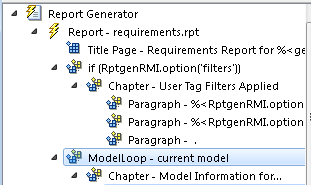
在最右侧窗格上,找到模型引用字段。如果您看不到该字段的下拉箭头,请展开窗格。
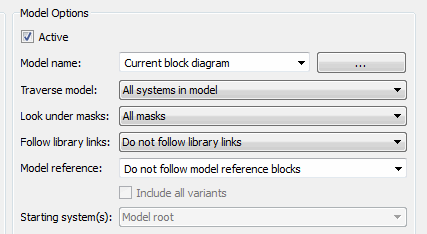
在模型引用字段下拉列表中,选择追踪所有模型引用模块。
要生成包含有关引用模型信息的开放模型需求报告,点击报告图标
 。
。
自定义需求报告
需求管理接口 (RMI) 使用 Simulink Report Generator 软件生成需求报告。您可以使用 Requirements Toolbox 或 Simulink Report Generator 软件自定义需求报告:
使用 Requirements Toolbox 设置自定义需求报告. 使用“需求设置”对话框可以自定义需求报告的多个选项。
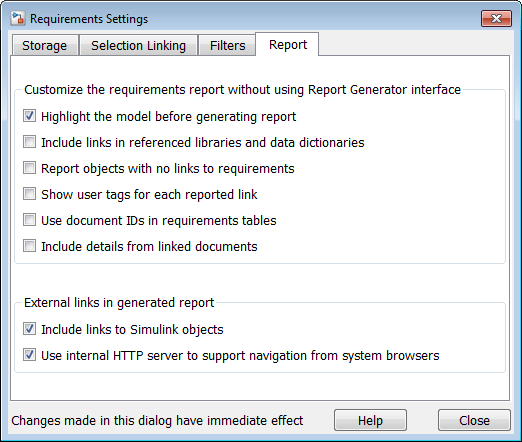
在报告选项卡上,选择指定报告中所需内容的选项。
| 需求设置报告选项 | 描述 |
|---|---|
在生成报告之前突出显示模型 | 可以在报告图形中突出显示符合需求的 Simulink 对象。 |
包含在引用的库和数据字典中的链接 | 在生成的报告中包含引用库中的需求链接。 |
报告没有需求链接的对象 | 包括没有需求的模型对象列表。 |
显示每个报告的链接的用户关键字 | 列出每个报告的链接的用户关键字(如果有)。 |
在需求表中使用文档 ID | 如果可用,则使用文档 ID,而不是需求报告表中的路径名。此功能可防止需求文档的长路径名扰乱报告表。 |
包含来自链接文档的详细信息 | 包括来自链接需求的附加内容。支持以下需求文档:
|
包括指向 Simulink 对象的链接 | 包括报告中到 Simulink 中的对象的链接。 |
使用内部 HTTP 服务器支持从系统浏览器导航 | 指定使用内部 MATLAB HTTP 服务器从生成的报告导航到文档和模型对象。通过选择此设置,只要 MATLAB 内部 HTTP 服务器在您的本地主机上处于活动,就可以从系统浏览器进行此导航。要启动内部 HTTP 服务器,请在 MATLAB 命令提示符下键入 |
要查看这些选项如何影响报告内容:
打开
slvnvdemo_fuelsys_officereq模型:openExample("slvnvdemo_fuelsys_officereq.slx")在 App 选项卡中,选择需求管理器。
在需求窗格中,将视图下拉菜单设置为链接。
在需求选项卡中,选择链接设置 > 链接选项。
在“需求设置”对话框中,点击报告选项卡。
对于此示例,选择在生成报告之前突出显示模型。
当您选择此选项时,在生成报告之前,报告中包含的模型的图形将突出显示,以便您可以轻松地看到哪些对象有需求。
要关闭“需求设置”对话框,点击关闭。
生成需求报告。在“需求”选项卡中,选择 S。
需求报告将在浏览器窗口中打开,以便您查看报告的内容。
如果您不想在重新生成需求报告时覆盖当前报告,请重命名 HTML 文件,例如
slvnvdemo_fuelsys_officereq_requirements_old.html。默认报告文件名为
model_name_requirements.html在需求选项卡中,选择 共享 > 生成模型可追溯性报告。
显示每个报告的链接的用户关键字 - 报告列出了与每个需求相关的用户关键字(如果有)。
包含来自链接文档的详细信息 - 该报告包含以下类型的需求文档中需求的附加详细信息。
需求文档格式 包括在报告中 Microsoft Word
需求的段落或小节的全文,包括表格。
Microsoft Excel
如果目标需求是一组单元格,则报告将所有这些单元格包含为一个表格。如果目标需求是一个单元格,则报告将包括该单元格以及目标单元格右侧该行中的所有单元格。
IBM DOORS
默认情况下,报告包括:
DOORS 对象标题
DOORS 对象文本
除创建方式、具有空字符串值的属性以及为 false 的系统属性之外的所有其他属性。
使用
RptgenRMI.doorsAttribs函数来包含或排除特定属性或属性组。
关闭“需求设置”对话框。
生成新的需求报告。在需求选项卡中,选择 共享 > 生成模型可追溯性报告。
将此新报告与您在步骤 7 中重命名的报告进行比较:
包括与需求链接相关的用户关键字。
需求内容的详细信息如步骤 9 所示。
审阅完报告后,关闭报告和模型。
使用 Simulink Report Generator 自定义需求报告. 如果您拥有 Simulink Report Generator 软件的许可证,您可以进一步修改默认需求报告。
在 MATLAB 命令提示符下,输入以下命令:
setedit requirements报告资源管理器 GUI 打开 Requirements Toolbox 在生成需求报告时使用的需求报告模板。报告模板包含 Simulink Report Generator 个组件,用于定义需求报告的结构体。
如果点击中间窗格中的某个组件,则可以为该组件指定的选项就会出现在右侧窗格中。有关使用特定组件自定义报告的详细信息,点击右侧窗格底部的帮助。
除了标准报告组件外,Simulink Report Generator 还在需求管理界面类别中提供了特定于 Requirements Toolbox 的组件。
| Simulink Report Generator 组件 | 报告信息 |
|---|---|
| 缺少需求模块循环 (Simulink Report Generator) | 将所有子组件应用于没有需求的模块 |
| 缺少需求系统循环 (Simulink Report Generator) | 将所有子组件应用于没有需求的系统 |
| 需求模块循环 (Simulink Report Generator) | 将所有子组件应用于具有需求的模块 |
| 需求文档表 (Simulink Report Generator) | 插入列出需求文档的表格 |
| 需求信号环路 (Simulink Report Generator) | 将所有子组件应用于有需求的信号组 |
| 需求摘要表 (Simulink Report Generator) | 插入一个属性表,其中列出了具有相关需求的模块的需求信息 |
| 需求系统循环 (Simulink Report Generator) | 将所有子组件应用于具有需求的系统 |
| 子系统需求表 (Simulink Report Generator) | 插入列出系统和子系统需求的表格 |
| 数据字典追溯表 (Simulink Report Generator) | 插入一个将数据字典信息与需求联系起来的表 |
| MATLAB 代码可追溯性表 (Simulink Report Generator) | 插入一个将 MATLAB 代码与需求联系起来的表格 |
| Simulink Test 套件可追溯性表 (Simulink Report Generator) | 插入一个将 Simulink 测试套件与需求联系起来的表格 |
要自定义需求报告,您可以:
添加或删除组件。
在报告层次结构中上移或下移组件。
自定义组件来指定报告如何呈现某些信息。
有关更多信息,请参阅 Simulink Report Generator 文档。
使用 Simulink 生成需求报告
当您在 Simulink 中打开模型时,模型编辑器提供了两个用于创建需求报告的选项:
系统设计描述报告. 系统设计描述报告描述了当前 Simulink 模型所代表的系统设计。
您可以使用系统设计描述报告来:
无需打开模型即可查看系统设计。
生成设计的摘要和详细描述。
评估是否符合设计需求。
以独立于建模环境的格式存档系统设计。
使用 Simulink Report Generator 软件构建报告的自定义版本。
要生成包含需求信息的系统设计描述报告:
打开您想要创建报告的模型。
在建模选项卡中,选择 比较 > 系统设计描述报告。
在设计描述对话框中,选择需求可追溯性。
选择您想要用于此报告的任何其他选项。
点击生成。
当软件生成报告时,状态会出现在 MATLAB 命令行窗口中。
报告名称是模型名称,后跟数字,后跟反映文档类型的扩展名(.pdf、.html 等)。
如果您的模型有链接需求,报告将包含一章需求可追溯性,其中包括:
具有需求的模型对象列表,其中包含用于显示对象的超链接
每个子系统的图像,突出显示具有需求的模型对象
设计需求报告. 在 App 选项卡中,点击需求管理器。在需求选项卡中,点击共享 > 生成模型可追溯性报告。此选项创建需求报告,如创建默认需求报告中所述。
要指定报告选项,请选择 共享 > 报告选项。在生成报告之前,在报告选项卡上设置所需的选项。有关这些选项的详细信息,请参阅 自定义需求报告。